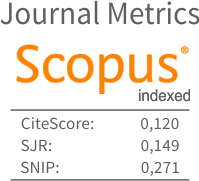Indicadores de Carbono en la Industria Farmacéutica: Huella de Carbono vs Huella Ecológica
DOI:
https://doi.org/10.21664/2238-8869.2022v11i1.p60-75Palavras-chave:
cambio climático, indicadores de medición de carbono, huella ecológica, huella de carbono, industria farmacéuticaResumo
El cambio climático se encuentra entre los factores de mayor interés a nivel mundial en los aspectos social y empresarial, la huella de carbono es un indicador que mide las emisiones de dióxido de carbono (CO2) que se realizan en la cadena de producción de bienes, desde la obtención de materias primas hasta el tratamiento de desperdicios. La huella ecológica es una medida real del impacto provocado por las actividades del ser humano en el medio ambiente y se determina según la cantidad de gases de efecto invernadero producidos. La propuesta es medir la huella ecológica de manera completa con la finalidad de considerar al carbono como la base y no únicamente al CO2, como es utilizado en las herramientas descritas. La presente investigación trabaja sobre el contexto internacional y metodologías para la medición del carbono, asimismo se efectúa un análisis comparativo entre la huella de carbono y la huella ecológica, sus alcances y diferencias, al igual que ilustrar su aplicación en la industria farmacéutica.
Referências
British Petroleum (BP). 2019. “Climate Change.” Reducing Emissions in Our Operations. 2019. https://www.bp.com/en/global/corporate/sustainability/climate-change/reducing-emissions-in-our-operations.html.
British Standards Institution (BSI). 2011. “ISO, Standards, Certificacion, News.” Newly Revised PAS 2050 Poised to Boost International Efforts to Carbon Footprint Products. 2011. https://www.bsigroup.com/en-GB/about-bsi/media-centre/press-releases/2011/9/NEWLY-REVISED-PAS-2050-POISED-TO-BOOST-INTERNATIONAL-EFFORTS-TO-CARBON-FOOTPRINT-PRODUCTS/.
———. 2018. “PAS 2060 Carbon Neutrality.” Demonstrate Your Carbon Neutrality. 2018. https://www.bsigroup.com/en-GB/PAS-2060-Carbon-Neutrality/.
Carballo Penela, A;, M. C; García-Negro, J. L; Doménech Quesada, C. S; Villasante, G; Rodríguez Rodríguez, and M. García Arenales. 2008. “A Pegada Ecolóxica Corporativa: Concepto e Aplicación a Dúas Empresas Pesqueiras de Galicia.” Revista Galega de Economía 17.
Carbon Trust. 2018. “Carbon Footprinting.” https://www.carbontrust.com/.
Chambers, N;, and K Lewis. 2001. “Ecological Footprint Análisis: Towards a Sustainability Indicador for Business.” ACCA Research Report No.65.
Climate Counts and the Center or Sustainable Organizations. 2013. “Assessing Corporate Emissions Performance through the Lens of Climate Science.” CIRED - Open Access Proceedings Journal. https://www.sustainableorganizations.org/.
Commission of the European Communities. 2008. “Communication from the Commission to the European Parliament, The Council, The European Economic and Social Committee and The Committee of the Regions on the Sustainable Consumption and Production and Sustainable Industrial Policy Action Plan.” Bruselas. https://eur-lex.europa.eu/legal-content/EN/ALL/?uri=CELEX:52008DC0397.
Council of the European Union. 2008. “Sustainable Consumption and Production and Sustainable Industrial Policy Action Plan. Council Conclusions.” Bruselas. https://register.consilium.europa.eu/doc/srv?l=EN&f=ST 16914 2008 INIT.
Doménech, J.L. 2004. “Huella Ecológica Portuaria y Desarrollo Sostenible.” Puertos, no. 114: 26–31.
Doménech, Juan Luis, and Mónica G. Arenales. 2008. “La Huella Ecológica de Las Empresas: 4 Años de Seguimiento En El Puerto de Gijón.” Observatorio Iberoamericano Del Desarrollo Local y La Economía Social 1: 21.
Global Footprint Network. 2016. “Ecological Wealth of Nations.” Global Footprint Network. https://www.footprintnetwork.org/.
Global Report Initiative (GRI). 2018. “Towards More and Better Reporting GRI Standards: A Global Common Language for Transparency.” https://www.globalreporting.org/SiteCollectionDocuments/2019/Towards more and better reporting - GRI Annual Report 2018.pdf.
Godoy, Emilio. 2008. “Inter Press Service. Agenda de Noticias.” CAMBIO CLIMÁTICO-AMÉRICA LATINA: Números Que Asustan. 2008. http://www.ipsnoticias.net/2008/11/cambio-climatico-america-latina-numeros-que-asustan/.
Heery, Edmund;, and Mike Noon. 2008. “PEST Analysis.” A Dictionary of Human Resource Management. Oxfor University Press. https://www.oxfordreference.com/view/10.1093/acref/9780199298761.001.0001/acref-9780199298761-e-936.
Holland, Leigh. 2003. “Can the Principle of the Ecological Footprint Be Applied to Measure the Environmental Sustainability of Business?” Corporate Social Responsibility and Environmental Management 10: 224–32.
ICF International Inc. 2018. “Work ICF.” Climate Action and Resilience. 2018. https://www.icf.com/work/climate.
Kitzes, J., A. Peller, S. Goldfinger, and M. Wackernagel. 2007. “Currents Methods for Calculating National Ecological Footprint Accounts.” Science for Environment & Sustainable Society 41: 1–9.
Lenzen, M; Foran, B; Dey, C. 2006. “Sustainability Accounting for Business-A New International Software Based on Input-Output Tables.” In Intermediate Input-Output Meeting Conference, 26–28 July Sendai, Japan.
Lenzen, Manfred; Lundie, Sven; Bransgrove, Grant; Charet, Lisa; Sack, Fabian. 2003. “Assessing the Ecological Footprint of a Large Metropolitan Water Supplier: Lessons for Water Management and Planning towards Sustainability.” Journal of Environmental Planning and Management 46: 113–41.
Lin, David, Laurel Hanscom, Adeline Murthy, Alessandro Galli, Mikel Evans, Evan Neill, Maria Mancini, et al. 2018. “Ecological Footprint Accounting for Countries: Updates and Results of the National Footprint Accounts, 2012–2018.” Resources 7 (3): 58. https://doi.org/10.3390/resources7030058.
Monfreda, C., M. Wackernagel, and D. Deumling. 2004. “Establishing National Natural Capital Accounts Based on DetailedEcological Footprint and Biological Capacity Assessments.” Land Use Policy 21: 231–46.
Murray, J; Dey, M. 2007. “Assessing the Impacts of a Loaf of Bread.”
Penela, Adolfo Carballo, María Do Carme García Negro, Juan Luis Doménech Quesada, Carlos Sebastián Villasante, Gonzalo Rodríguez Rodríguez, and Mónica González Arenáles. 2008. “La Huella Ecológica Corporativa: Concepto y Aplicacion a Dos Empresas Pesqueras de Galicia.” Revista Galega de Economia 17 (2).
Rees, William E. 1992. “Ecological Footprints and Appropriated Carrying Capacity: What Urban Economics Leaves Out.” Environment and Urbanization 4 (2): 121–30.
Secretaría de Medio Ambiente y Recursos Naturales. 2012. Huella Ecológica, Datos y Rostros. Centro de.
Wackernagel, M; Rees, W. E. 1996. “Our Ecological Footprint: Reducing Human Impact on the Earth.” New Society Publishers. Philadelphia, USA.
Wackernagel, M;, and J. Silverstein. 2000. “Big Things First: Focusing on the Scale Imperative with the Ecological Footprint. Ecological Economics.” Ecological Economics 32: 391–94.
Wackernagel, M., N. Schulz, D. Deumling, A. Callejas Linares, M. Jenkins, V. Kapos, C. Monfreda, et al. 2002. “Tracking the Ecological Overshoot of the Human Economy.” In National Academy of Science 99, 9266–71.
Wackernagel, Mathis;, and J. David Yount. 2000. “Footprints for Sustainability: The Next Steps.” Environment, Development and Sustainability 2: 23–44.
Wackernagel, Mathis. 1994. “Ecological Footprint and Appropriated Carrying Capacity: A Tool for Planning toward Sustainability.” The Swiss Federal Insitute of Technology, Zúrich, 1988.
———. 1998. “The Ecological Footprint of Santiago de Chile.” Local Environment 3: 7–25.
Wiedmann, Thomas; Lenzen, Manfred. 2006. “Sharing Responsibility along Supply Chains - A New Life-Cycle Approach and Software Tool for Triple-Bottom-Line Accounting.” In Working Paper Presented at the Corporate Responsibility Research Conference, 4–5.
Wiedmann, T., J. Barret, and M. Lenzen. 2007. “Companies on the Scale: Comparing and Benchmarking the Footprints of Businesses.” In Working Paper Presented at the International Ecological Footprint Conference.
Wiedmann, T., and M. Lenzen. 2007. “Unravelling the Impacts of Supply Chains. A New Triple-Bottom-Line Accounting Approach. ISA UK Research Report.”
Wiedmann, T., and J. Minx. 2007. “A Definition of Carbon Footprint. ISA UK Research Report.” Durhan, U.K.
World Resources Institute;, and World Business Council for Sustainable Development. 2019. “Greenhouse Gas Protocol.” Corporate Value Chain (Scope 3) Standard. 2019. https://ghgprotocol.org/standards/scope-3-standard.
Downloads
Publicado
Como Citar
Edição
Seção
Licença
Esta revista oferece acesso livre imediato ao seu conteúdo, seguindo o princípio de que disponibilizar gratuitamente o conhecimento científico ao público proporciona maior democratização mundial do conhecimento.
A partir da publicação realizada na revista os autores possuem copyright e direitos de publicação de seus artigos sem restrições.
A Revista Fronteiras: Journal of Social, Technological and Environmental Science segue os preceitos legais da licença Creative Commons - Atribuição-NãoComercial 4.0 Internacional.


